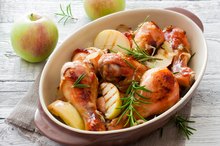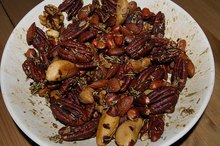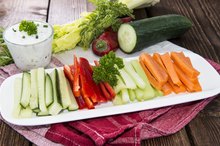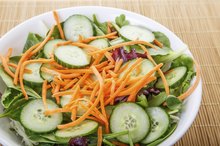Insulin Resistance Diet Plan
If you're carrying extra weight and not getting sufficient exercise, you may be at risk of insulin resistance, which is when your body does not effectively use the insulin it produces. Most people who have insulin resistance do not know they have it, according to the National Institute of Diabetes and Digestive and Kidney Disorders; if left untreated, it can ultimately lead to type 2 diabetes. Losing weight and following the Dietary Approaches to Stop Hypertension, or DASH diet, may help reverse insulin resistance.
Calories
When trying to lose weight to reverse insulin resistance, you must eat fewer calories than you currently consume. Use an online food diary to help you count your usual calorie intake. Decreasing your daily intake by 500 calories produces a 1-pound weekly weight loss.
Grains
The Recommended Daily Values for a 1,200-Calorie Diet
Learn More
Grains are an important source of energy on your diet plan. How much you need to eat each day depends on your weight loss calorie needs. For a 1,600- to 2,000-calorie diet, aim for six to eight servings a day. Eat fewer servings if you need fewer calories. A grain serving includes one slice of bread or 1/2 cup of cooked rice. Most of your grains should come from whole grains, such as whole-grain breads and cereals, to maximize nutrient and fiber intake.
Fruits and Vegetebles
Fruits and vegetables are filling and low in calories. On your insulin resistance diet plan, eat three to five servings of vegetables each day and four to five servings of fruit. A vegetable serving is equal to 1 cup of raw vegetables or 1/2-cup cooked, while a serving of fruit is equal to a medium piece of whole fruit or 1/2 cup of fresh cut fruit.
Protein
Why Are Fats Important in a Diet?
Learn More
Protein choices on your DASH diet for insulin resistance include poultry, fish and lean red meat. Choosing leaner sources of protein reduces your intake of calories and saturated fat. You should limit your daily intake of protein foods to 3 to 6 ounces a day.
Dairy Foods
Dairy foods provide protein and calcium. You should get two to three servings of dairy foods a day on your insulin resistance diet plan, in which 1 cup of milk or 1 1/2 ounces of cheese equal one serving. Choose low-fat and nonfat dairy foods to limit both fat and calories.
Nuts, Seeds and Legumes
Nuts, seeds and legumes are nutrient-rich foods that provide protein, essential vitamins and fiber. On your diet plan, get three to five servings of these foods each week. One-third cup of nuts or 1/2 cup of cooked legumes is considered one serving.
Fats and Oils
Fat is a concentrated source of calories; portion size is important when watching your calorie intake. On your diet plan, get two to three servings of fat a day, which is 1 teaspoon of oil or 2 tablespoons of salad dressing. So-called "good" fats, such as olive oil or vegetable oil, are healthier choices.
Related Articles
References
Writer Bio
Jill Corleone is a registered dietitian and health coach who has been writing and lecturing on diet and health for more than 15 years. Her work has been featured on the Huffington Post, Diabetes Self-Management and in the book "Noninvasive Mechanical Ventilation," edited by John R. Bach, M.D. Corleone holds a Bachelor of Science in nutrition.









